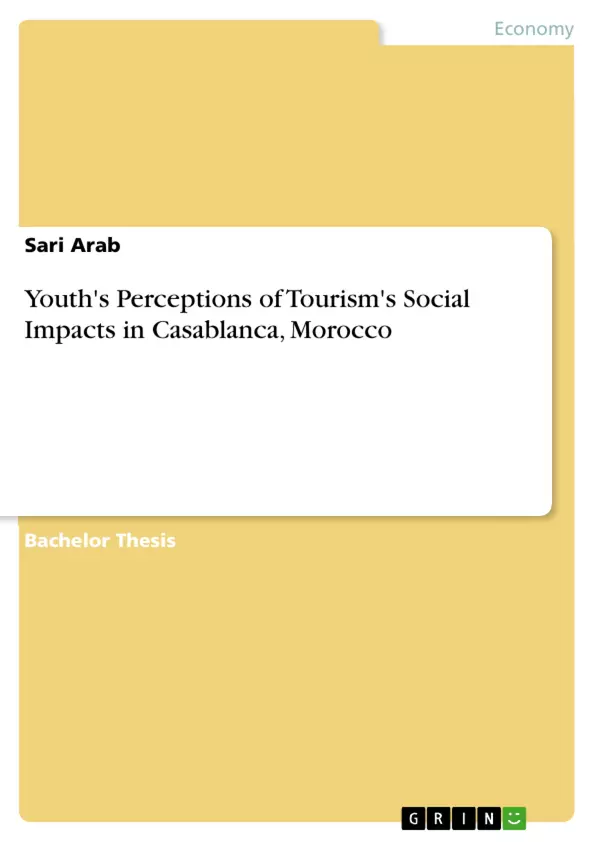This dissertation aims to investigate the perceptions and attitude of young citizens towards the social impacts of tourism in Casablanca, Morocco. Tourism is known to have both positive and negative social impacts on any community and significant research has been done on how host communities perceive it. However, little research has been implemented on the perceptions of young people particularly. The first objective was to review secondary data regarding the topic. The reviewed literature presents different models and theories such as Doxey's Irritation Index, Butler's Cycle and the Social Exchange Theory. A primary fieldwork research was designed to meet the second objective of investigating the perceptions of the youth. The research was carried out through an e-survey and a total sample of 301 people in Morocco. The collected data were analyzed and the results were compared with the findings from the literature review. Some of the findings were indeed surprising. Although most of the respondents think that tourism has a good impact on their city, opinions vary according to age, gender, income and ethnic background. Casablanca is yet to become a mature destination and measures need to be taken to avoid future irritation among locals. Most notably, hospitality managers should provide women with adequate working conditions and the Moroccan government should prioritise tourism as an economic activity but also as means for social cohesion and social sustainability.
Table of Contents
- CHAPTER 1: INTRODUCTION
- 1.1 Background to the Research
- 1.2 Aim
- 1.3 Objectives
- 1.4 Structure of the Dissertation
- CHAPTER 2: LITERATURE REVIEW
- 2.1 Introduction
- 2.2 Tourism Development in Morocco
- 2.2.1 Morocco
- 2.2.2 Casablanca
- 2.2.3 Tourism Development
- 2.3 Socio-cultural Impacts
- 2.3.1 Social Impacts
- 2.3.2 Alienation
- 2.3.3 Acculturation
- 2.3.4 Demonstration Effect
- 2.4 Tourism Impacts and Host Community Perceptions
- 2.4.1 Host Perceptions
- 2.4.2 Doxey's Irritation Index
- 2.4.3 Butler's Cycle
- 2.4.4 Social Exchange Theory
- 2.5 Social Impact Assessment
- 2.5.1 Social Impact Assessment in Tourism
- 2.5.2 Social Resource Unit
- 2.5.3 Interactive Community Forum
- 2.5.4 Surveying
- 2.6 Conclusions
- CHAPTER 3: METHODOLOGY
- 3.1 Introduction
- 3.2 Secondary Research
- 3.2.1 Literature Search
- 3.2.2 Literature Review
- 3.3 Primary Research
- 3.3.1 Qualitative Research
- 3.3.2 Quantitative Research
- 3.3.3 Research Instrument Design
- 3.3.4 Sampling Strategy
- 3.3.5 Conducting the research
- 3.4 Data Analysis
- CHAPTER 4: ANALYSIS OF RESULTS
- 4.1 Introduction
- 4.2 Results and Analysis
- 4.2.1 Demographics
- 4.2.2 Survey Analysis
- 4.2.3 Open-ended Questions
- 4.3 Conclusion
- CHAPTER 5: CONCLUSIONS, RECOMMENDATIONS AND REFLECTIONS
- 5.1 Introduction
- 5.2 Conclusions
- 5.3 Recommendations
- 5.3.1 For Tourism Planners and Stakeholders
- 5.3.2 For Hospitality and Tourism Businesses
- 5.3.3 For Participants and Casablancan Youth
- 5.4 Reflections and Evaluation of Methodology
- 5.5 Suggestions for Future Research
Objectives and Key Themes
This dissertation aims to examine the perspectives of young residents in Casablanca, Morocco, regarding the social repercussions of tourism. The study seeks to understand how young people perceive the various impacts of tourism on their city and to identify potential solutions to mitigate negative effects.
- The social impacts of tourism on a community
- The perceptions and attitudes of young people towards tourism
- The role of tourism in economic development and social cohesion
- The impact of tourism on gender equality and working conditions
- The need for sustainable tourism practices in Casablanca
Chapter Summaries
The dissertation is structured into five chapters, each focusing on a specific aspect of tourism's impact on Casablanca.
- Chapter 1: Introduction: This chapter provides an overview of the research topic, outlines the research aims and objectives, and presents the structure of the dissertation.
- Chapter 2: Literature Review: This chapter examines existing research on the social impacts of tourism, particularly focusing on the perceptions of local communities. It explores theoretical frameworks, such as Doxey's Irritation Index and Butler's Cycle, to understand the dynamics of tourism development and its effects on host populations.
- Chapter 3: Methodology: This chapter details the research methodology employed in the study, outlining both secondary and primary research methods. It explains the data collection and analysis techniques used to investigate the perceptions of young people in Casablanca.
- Chapter 4: Analysis of Results: This chapter presents the findings of the research, analyzing the collected data to identify key trends and patterns in the perceptions of young people. It examines how demographic factors influence their attitudes towards tourism and its impact on the city.
Keywords
The primary themes and concepts explored in this dissertation include: tourism, social impacts, youth perceptions, Casablanca, Morocco, sustainable tourism, social cohesion, gender equality, working conditions, Doxey's Irritation Index, Butler's Cycle, Social Exchange Theory.
- Arbeit zitieren
- Sari Arab (Autor:in), 2016, Youth's Perceptions of Tourism's Social Impacts in Casablanca, Morocco, München, GRIN Verlag, https://www.grin.com/document/370856



